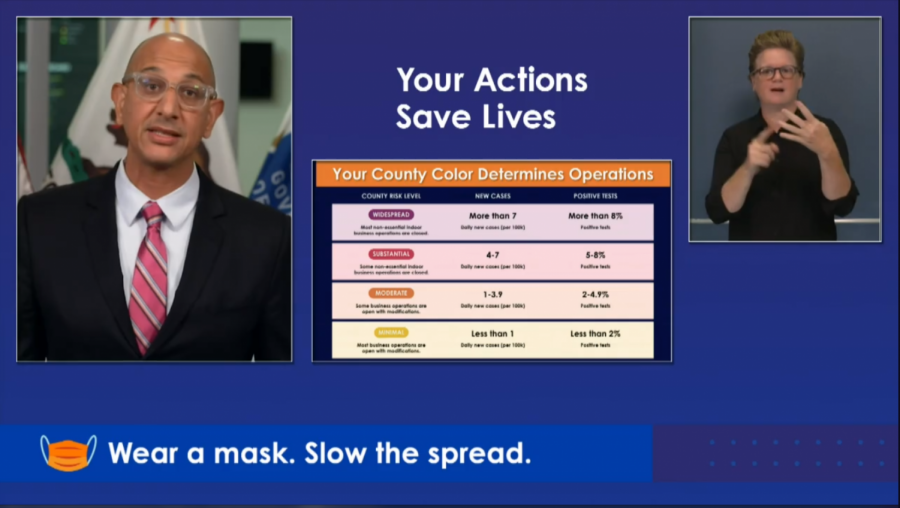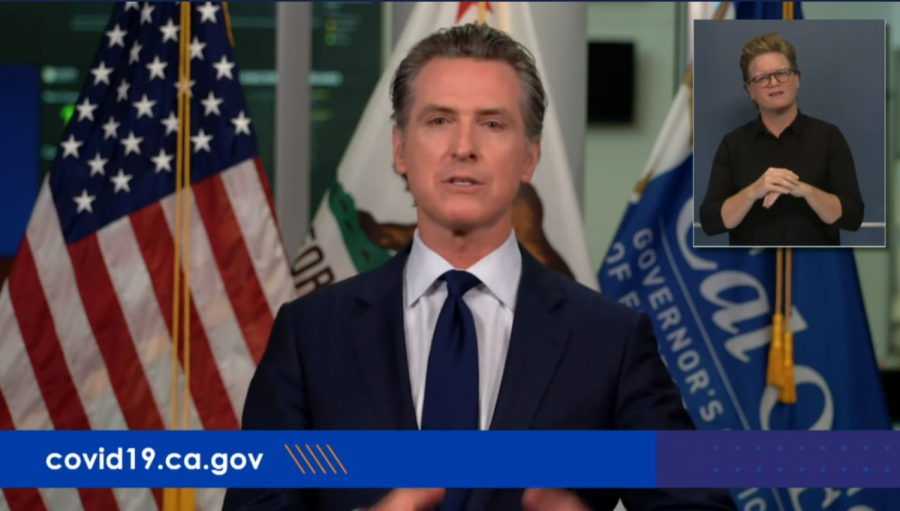Governor Newsom addresses historic wildfire season and unveils the ‘Blueprint for a Safer Economy’ initiative
California Governor Gavin Newsom delivers an address via live stream to Californians regarding ongoing wildfires and COVID-19 on Tuesday, Sept 8.
September 11, 2020
On Sept. 8, California Governor Gavin Newsom discussed the state’s efforts to combat its historic fire season and unveiled the new Blueprint for a Safer Economy initiative.
Newsom provided updates on the progress of nine active wildfires throughout the state, which include the El Dorado fire and the Bobcat fire. This year’s fire season is unprecedented in magnitude and breadth with 7,606 fires. In 2019, only 118,000 acres burned at this time last year, and nearly 2.3 million acres have burned in 2020 thus far.
“Historic is a term we seemingly use often here in the state of California, but these numbers bear fruit to that assertion that this is historic,” said Newsom. “It’s rather extraordinary, the challenge that we faced again, so far, this season 2020.”
With nearly 14,000 firefighters and over 9,000 fire engines battling the fires, the state is focusing all of its resources on fire containment. Additional support from the California Conservation Corps and the state’s mutual aid system have contributed to containment efforts.
The Memorial Day weekend heatwave exacerbated wildfire conditions as several counties reached record high temperatures. Los Angeles County reached a new highest recorded temperature of 121 degrees in Woodland Hills, which was one degree cooler than Death Valley.
“I have no patience. And I say this lovingly, not as an ideology, but as someone who prides himself on being open to argument, interested in evidence. But I quite literally have no patience for climate change deniers,” said Newsom. “You may not believe it intellectually, but your own eyes, your own experiences, tell a different story, particularly out here in the west coast of the United States and particularly here in the state of California.”
The heatwave placed intense pressure on the state’s energy supply in order to keep Californians cool in the hot weather. Newsom expressed his gratitude for the cooperation of counties, energy companies, and officials in their actions to conserve energy.
Additionally, Newsom also addressed the state’s COVID-19 updates and noted that hospitalizations have dropped 24% and ICU admissions have decreased 21% over the past 14 days. The statewide positivity rate has decreased from 4.3% to 3.8% over a seven day period.
Dr. Mark Ghaly, the secretary for the California Health and Human Services Agency, discussed the Blueprint for a Safer Economy initiative implemented statewide. Now, every county will be given one of four color tiers that determine the level of easing COVID-19 restrictions on non-essential businesses and activities.
“Widespread is purple, substantial is red, moderate transmission is orange, and minimal is yellow. And each of these on a weekly basis, every Tuesday, we’ll be announcing where counties are relative to their tiers,” said Ghaly.

Ventura County was given a purple tier color, which indicates that the county risk level is widespread and there are more than seven new cases daily per 100,000 people. Therefore, non-essential businesses and activities must remain closed until COVID-19 conditions improve. Each county must remain in their color tier for three weeks before moving between tiers.
When asked about handling the two crises of COVID-19 and wildfires, Newsom expressed hope that the state is equipped and trained to mitigate both situations.
“Well, we’re resilient. We’ll get through this. It’s not a permanent state,” said Newsom. “We have a remarkable capacity to meet these challenges head-on, and we are committed not only to address the immediate but to address the medium and long term by doing much more than we’ve done in the past, recognizing the enormity of challenge that we face.”
For more information on the Blueprint for a Safer Economy, visit the California Coronavirus Response website.









